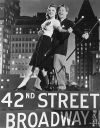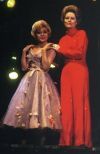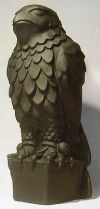Analyzing Sweeney Todd solely based on the original production
#1Analyzing Sweeney Todd solely based on the original production
Posted: 10/26/06 at 3:54pm
Since I started doing some research on the original production, I've just learned fascinating things about the show, so I thought since we all had been analyzing the revival for a while, it might be interesting to bring up some things I learned of the original production. It's really interesting--some of course, certainly apply to the revival, some nuances are different...Obviously a lot of this is well-known by most of you but still just wanted to get down all the thoughts running around in my head...
The analysis I'm focusing on in particular is the music, which I find most fascinating.
Bond was the first playwright who portrayed Sweeney with believable motives--a big reason Sondheim was drawn to his work in particular. In other stories, Sweeney was just greedy and murdered for the sake of it.
Sondheim incorporates modern musical aspects into his score, though also using music that mimics the time period, allowing the audience to buy into the time period but also perceive the connection to modern society.
Sondheim initially wanted solely to adopt it into an opera, but he couldn't figure out how to get it to a manageable size, and that's when he asked Hugh Wheeler to collaborate with him. Still, it's quite close to an opera.
Prince only agreed to direct Sweeney when he saw the comparisons to the Industrial Revolution.
The opening scene/set depicts the social order of nineteenth-century England. The shriek of the factory whistle serves not only to scare the audience, but to focus on the factory, where most of the workers were during the Industrial Revolution, and demonstrates the power of the owners.
Obviously, the use of "attending the tale" shows the audience we are seeing a legend that will teach of corruption, oppression and revenge, and like all moral tales, will have universal implications.
The song begins in the lowest possible register, reflecting the mood. As I remember Sondheim mentioning in Broadway: The American Musical, the opening chords have a building motion that goes nowhere--the audience waits for something but nothing happens, building the tension.
The chorus fuctions like the Dies Irae, high point of the Catholic funeral mass.
When Sweeney ascends, the accompaniment reflects the turbulence of Sweeney's emotions, and the frenzy of the machine age.
The gentle accompanyment to the beginning of No Place Like London purposely contrasts with the horrors that lie ahead in the show.
Every character except Sweeney and Mrs. Lovett are represented in complete terms of melodramatic characterizations. Anthony is the naive optimist. His name of Hope is even symbolic.
Each character is identified with a particular musical theme--all their music evolves from that theme and each song depends on the one priot to it. Anthony's identity, good humor, and identity are reflected in his theme.
The Beggar Woman can be seen as a symbol of the effects of a corrupt society. The music and tone completely change from her pretty soprano begging for money, to when she offers herself.
A musical clue is also presented in this scene, as the raunchy tune she sings becomes the minuet later played in the scene that flashes back to the rape of Sweeney's wife.
As another hint, after she leaves them, Sweeney claims there are "ghostly shadows everywhere."
When Sweeney sings about London, he is so disgusted with it, he spits it out more than he sings about it. Heavily contrasted with Anthony's pretty expression of his view.
In Barber and His Wife, it is important to note the repititon of "she was beautiful." the repeated words and simple phrases contribute to a sense of his sheer commitment to his lost marriage, but everything in the song changes when he sings about how his life was destroyed. The word naive goes against what we expect in melody, and is a very low note, which reflects his descent into misery.
Sondheim also reflects how much when he wrote for Lovett, he knew he was writing for Angela...which makes it fascinating to think about what other actresses have accomplished with the part.
There was debate around the idea of contrasting Sweeney's gloom and misery with Lovett's humor. A few critics thought it was a mess, and disintegrated. (Simon was one of these critics--did he review the revival? I couldn't find it. I'm curious, since the humor was darkened, if he preferred that version).
However, most believe the combination of gloom and humor is effective--they reinforce each other without losing their importance. The comedy magnifies the horror. The humor in Sweeney distances the horror but does not trivialize it.
Lovett not only uses her recount to confirm that Sweeney is Barker, but also to seduce him ("he was beautiful.")
Little is one of Sondheim's favorite words. Lovett uses it to suggest vulnerability and weakness--she says the wife was a "pretty little thing" and a "silly little nit." She repeats the phrase "poor thing," devaluing its meaning each time.
In My Friends, Sweeney and his blades become one. In fact, aside from the beginning with Lucy, the only love Sweeney expresses in the whole show is love of killing machines (my friends here, another friend to describe the chair). Obviously contrasts with Lovett's love for him. His passion goes into his blades, and a sexual union is even suggested.
There's a huge contrast between Sweeney and Johanna in the bridge from his song to hers. Sweeney rises from the depths--he came out of the grave, and also sings low notes, while Johanna descents from the heights--she appears at the highest level of the Judge's mansion and sings high notes.
Johanna's character is also a perfect stereotypic melodramatic character. There is always a threatened seduction of a pure young innocent, and she must face many obstacles to try to find true love.
Johanna's state even changes in Green Finch. She first describes the bird's melody as "rejoicing" but later calls it "screaming." She often demonstrates she feels kind of like an ornament, not a real person, and only her decorative value is important.
Sondheim also wanted to include a clear sexual tension rising in the first "Johanna."
In Pirelli's elixir, a tension is achieved because the ensemble is divided into those who want to buy hair tonic and those who don't. A lot of rhymes in this song are similar to those of Cole Porter...rhyming elixir with "trick, sir"; "quick sir"; and "tick sir."
Apparently this scene is the most criticized in at least the original production. They understand it's importance to the plot, but they feel it interrupts the action too much and isn't as funny as it should be (is that one of the reasons the teeth scene is often cut? to cut down this scene?)
Also interesting, when Lovett suggests the throat-cutting gesture for Sweeney to do with Anthony...it makes HER the first to mention throat slitting, not him.
Now, I've always been confused about the Judge's Johanna. Was it actually cut from the original production, as in before it opened? I knew it was cut from subsequent versions, but I guess just b/c it's on the OBC CD, I never realized it might have even been cut from the original as well. What is everyone's thoughts on that? Is it a necessary song or should it be cut? Apparently it was cut for the sake of making the show shorter, even though it allows for more character development. So if it WAS cut from the original, was this revival the first to put it back in? Did the Teeny Todd Revival put it back in?
Ladies and their sensitivies actually provides a perfect example of a major theme between the appearance of outer beauty in the Victorian era and the ugliness on the inside of people. The Beadle purposely uses very big words to present himself as intelligent, but makes a tiny grammatical slip ("they resents it"), parallelling the ugly inside.
I never realized what an impact "Wait" has on "Pretty Women"--that the reason he hesitates so is because he listened to Lovett, wanting to prolong having the Judge under his power. I always thought that was just an idea he had...
Pretty is also another of Sondheim's favorite words. Here, pretty contrasts with the dark passion of Sweney and the judge. And again the theme of appearance vs. reality is reflected in the apparent jolliness of the song. The melody purposely distances itself from the horror. Apparently in the show, the more evil the horror, the more lyrical the music.
Obviously, Epiphany is his breakdown, where his vengeance goes from personal to universal. He also purposely mentions the oppressiveness of capitalism--that the only escape is death ("Because the lives of the wicked should be made brief. or the rest of us, death will be a relief--we all deserve to die!") There's a dualistic theme to the song of life and death, and of vengeance and salvation.The music reflects the splintering of Sweeney's personality, and the engine pounding under the song. There is distinct disintegration in the music, as there's short stacatto right near long sustained notes. The lyric that concludes the song is a triumphant one, but the musical line strongly denies that triumph.
This certainly could conclude act 1, but Sondheim wanted the comedy in the show to be equal to the tragedy, which is why he chose to end on A Little Priest. This song is structured like a typical British music hall turn. And even differences in Sweeney and Lovett are still demonstrated here. Lovett gets carried away, but Sweeneey never forgets the plan's relevance (him reciting the chorus).
As for God That's Good, Calvin, with your comparing Sweeney to the seven sins seems to take on a truth. The customers are referred to as "gluttonous." Go you! Also referred to as consuming greedily.
And I never realized the importance of Tobias' part in the song. The sales pitch is a complete satire on deceptive advertising.
It is also important because in this song, Sweeney's vision of cannibalism is realized, but he doesn't seem to care. But like he says in Epiphany, no single number amount of men will truly fulfill him, so it makes sense.
Once again, Sweeney sings a love song to a machine of death--in this case, the chair. He is being a sort of capitalist in his own right, perfecting and economizing the process of murder.
Johanna act 2...well, I knew there was a reason this is my favorite song in the show. Gah, the things that come out of it. First Anthony's lonely opening of the song illustrates that there still can be love in this corrupt world. But the whole point of Sweeney singing the song is to demonstrate how detached he has become of his own humanity (I'm fine Johanna...I miss you less and less), and it perfectly works in as he slits the throats. There's also a contrast in their words--Anthony's of hope, Sweeney's of good-bye.
The Beggar Woman here serves as the conscience of the city. It is also important to note she brings in a lot of religious references.
Lovett's complexity as a character is demonstrated in By the Sea. She is quite immoral, but still wants to be respectable--and married. The rhyming of proper and chopper in this song is particularly effective.
Apparently she plays here comes the bride at the end of the song. Didn't know that.
At this point in the show, the chorus begins to sound more-machine like.
Again obviously, in Not While I'm Around, Tobias casts Lovett as a Damsel in Distress, and tries to apply chivalristic principles. The music also reflects the song great, as everything gets much shorter and staccato and the notes ascend as he gets more anxious to convince Lovett that she is in danger. When Lovett repeats the love song, it takes on a menacing tone.
Then the chorus transforms itself into the inmates of Fogg's asylum (until now, the chorus has very much apparently served as a Brechtian chorus). A certain stylization exists in Sweeney, where climactic moments are intensified with intense theatrical devices.
City on Fire carries a very important theme. It is sung by the inmates, to show they are the only ones who know the truth about what's going on. This parallel's the Beggar Woman's refrain in Johanna--showing an idea that only the deranged can clearly see the truth behind appearances. It is also important that factory whistles are brought together with police whistles, showing the corruptness of both the law and the capitalists.
This is also Sondheim's first show where he makes wide use of reprises. He used to not think that as characters developed they should repeat previous emotional themes, but these reprieses occur to develop the characters and their relations. They come up more and more near the end of the show.
The show also kind of tricks you if you haven't realized the true identity of the Beggar Woman. You think the ultimate horror is going to occur, that Sweeney will kill Johanna, but then he doesn't, you think it's avoided. But then you realize by killing Lucy, it has already occurred.
After Sweeney kills Lovett, he repeats exactly what he sang at the beginning of the show. Nothing has changed. He still feels as hopeless as he did at the beginning.
When Tobias kills him, Sweeney can be seen as a tragic hero by him not resisting death. He must die because he understands how he has been both a victim and an instigator. The whole show is ambigious as good/evil, right/wrong cannot be clearly defined in Sweeney (sheds light on that thread asking if Sweeney is evil)
The repititon of the ballad once again signifies that this has been a story, not a series of real events. But of course there's the part where they point at everyone, accusing that they have a bit of Sweeney in them.
Some critics misunderstood this, and thought that the point was the audience was murderous like Sweeney, when the lyrics themselves show the tendency to want revenge is what is in us, not that we're gonna become homocidal murderers--that at times we can find cruelty and destruction appealing.
Another fascinating aspect of the show is that there is no simplistic moral that can be taken. Sweeney could have become a heroic figure of the underclass, and only disposed of the upper class, but he did not. His emotions override good/evil and he becomes more than human, but dehumanized.
I can't get over how most of Sondheim's works, but especially Sweeney has...just...so much to think about, so many decisions important meanings. Wow.
I am not becoming a Sondheim fanatic
I am not becoming a Sondheim fanatic
No, I am not unworthy of his words...
(Anyone buying this?)
#2re: Analyzing Sweeney Todd solely based on the original production
Posted: 10/26/06 at 4:07pmBravo on all of those details!
#3re: Analyzing Sweeney Todd solely based on the original production
Posted: 10/26/06 at 4:08pm
Two things:
The Judge's "Johanna" was cut during previews. The reasons vary, depending on whom on the creative team you ask. Hal Prince claims he couldn't find an acceptible way to stage it, whereas Sondheim, I believe, has said it was cut because it made audiences uncomfortable.
"Wait" is actually one of Sondheim's least favorite songs he's ever written for a musical. He was happy to trim it from the Tim Burton film because as he (rightly)says, "Why would Mrs. Lovett sing a Latin samba in 19th century London?"
Ciaron McCarthy
Broadway Star Joined: 10/15/06
#4re: Analyzing Sweeney Todd solely based on the original production
Posted: 10/26/06 at 4:09pm
Also interesting, when Lovett suggests the throat-cutting gesture for Sweeney to do with Anthony...it makes HER the first to mention throat slitting, not him.
Lovett is Sondheims greatest villian! She is more evil than the judge. Love her!!
#5re: Analyzing Sweeney Todd solely based on the original production
Posted: 10/26/06 at 4:15pm
He was happy to trim it from the Tim Burton film because as he (rightly)says, "Why would Mrs. Lovett sing a Latin samba in 19th century London?"
Ha. I love "Wait", but I agree. And I'm also sort of in love with the fact that Stephen Sondheim constantly pokes fun at himself.
#6re: Analyzing Sweeney Todd solely based on the original production
Posted: 10/26/06 at 4:16pm
Thank you, Mr. Bennett 
So, was this revival the first time the Judge's Johanna was put back in, or was it in some earlier reincarnation--whether one of the opera performances or the Teeny todd revival?
Hmm, interesting about Wait. Is there an article you can link about that, or just...head knowledge? So since Pretty Women seems to come out of themes in that song, how do you think they will compensate? Or might it just not be/seem that important?
#7re: Analyzing Sweeney Todd solely based on the original production
Posted: 10/26/06 at 4:22pm
"So, was this revival the first time the Judge's Johanna was put back in, or was it in some earlier reincarnation--whether one of the opera performances or the Teeny todd revival? "
It was in the San Fransico DVD release starring LuPone and Hearn too.
#8re: Analyzing Sweeney Todd solely based on the original production
Posted: 10/26/06 at 4:22pm
The Judge's "Johanna" was restored for the NYC Opera Version in the early 80s and has been in every major revival since. I'm not sure if Sondheim has said that about "Wait" in print or not, though I believe he has.
Nobodyhome knows more about SWEENEY than any person I know - I would pm him...
#9re: Analyzing Sweeney Todd solely based on the original production
Posted: 10/26/06 at 4:25pmThe Judge's "Johanna" was originally cut for a number of reasons--all pointed out above. The other reason not mentioned was that the number was simply too difficult for the actor (Edmund Lyndeck) to perform each night. I think it made him uncomfortable...
"Time flies like an arrow, fruit flies like a banana." GMarx
#10re: Analyzing Sweeney Todd solely based on the original production
Posted: 10/26/06 at 4:55pm
I had no idea that the Judge's "Johanna" was cut from the original production. I can understand why it would be difficult to stage and perform each night. In the original script, the stage directions call for the Judge to whip himself repeatedly during the course of the song. I can also see how that might make audiences uncomfortable.
Wickedrentq, thanks for the analysis. Sweeney Todd is a such a brilliant and in-depth piece of theatre, you could probably hold a seminar just to analyze it.
On another note, does anyone know where I might find some pictures of the original production? I've seen the DVD of the touring production, but I've heard that the production at the Uris (now Gershwin) theatre actually incorporated parts from a factory, and I'm curious to see how that looked.
Ciaron McCarthy
Broadway Star Joined: 10/15/06
#11re: Analyzing Sweeney Todd solely based on the original production
Posted: 10/26/06 at 5:03pmMy father saw the original Judges Song. He said it was so creepy and daring and was pissed it was cut. It is vital to the character of the judge. It is understandable why it was cut though.
#12re: Analyzing Sweeney Todd solely based on the original production
Posted: 10/26/06 at 5:16pm
A brave as Hal Prince has been through his career, there have been several times where he's been quite a coward. One was when he made Fred Ebb cut "She wouldn't look Jewish at all" from The Gorilla Number in Cabaret. (Understandable for the time though). The second was when he wanted to soap up the ending of Company and made Sondheim write a more optimistic closer. (Being Alive is of course wonderful though) and the third is the cutting of the Judge's song. While it made audiences cringe, this probably was one of the weakest moves in his career. The show plays better with the scene and it really furthers the character development of Judge Turpin.
This is one of the best discussions we've had on this board. Truly in depth. I haven't gotten through everyone's comments, but I'd like to add (it may have been said) that I feel Mrs. Lovett is the one of the real villians of the piece She is a phoney, besides having an obsession with money and marrying Sweeney Todd. Of course, (I've read this in articles, so it's nothing new) she is written so people come out loving her, but anaylizing the piece proves that Mrs. Lovett is more of a villian than Sweeney Todd.
SporkGoddess
Broadway Legend Joined: 7/27/05
#13re: Analyzing Sweeney Todd solely based on the original production
Posted: 10/26/06 at 5:23pm
That was amazing! Thank you sooo much for sharing! I am definitely passing this on to friends of mine who also love Sweeney. ![]()
I never noticed the Beggar Woman's tune being repeated during the rape sequence. I'll have to listen for it next time... how interesting!
MargoChanning
Broadway Legend Joined: 4/5/04
#14re: Analyzing Sweeney Todd solely based on the original production
Posted: 10/26/06 at 5:38pmI don't have my original program handy, but I would swear I remember seeing the Judge's Johanna in the original tour production of the show (with Lansbury and Hearn) at the Kennedy Center back around 1980 or so. I clearly remember the image of the old judge shirtless and flagellating himself on stage and being somewhat disturbed by it. Is it possible that it was re-inserted for the tour (or at least the DC tour stop) or am I somehow confusing it with the City Opera production a few years later? Perhaps my memory is playing tricks on me, but I'm almost sure I saw it in the tour production.
#15re: Analyzing Sweeney Todd solely based on the original production
Posted: 10/26/06 at 5:42pm
The Judge's "Johanna" was in the Australian premire production in 1988 and has been in every version i have seen in this country.
Great post Wickrentq.
#16re: Analyzing Sweeney Todd solely based on the original production
Posted: 10/26/06 at 5:53pmMargo, I also remember the Judge's "Johanna" in the tour when it played in Chicago. I don't remember why it didn't appear in the LA stop which is the DVD performance.
"Time flies like an arrow, fruit flies like a banana." GMarx
elmore3003
Leading Actor Joined: 3/31/04
#17re: Analyzing Sweeney Todd solely based on the original production
Posted: 10/26/06 at 6:11pm
Between the last weekend of June 1979 and March 1980 when Carious and Lansbury left the show, I saw it six times. The toothpulling scene and Judge Turpin's flagellation scene were missing.
Did wickedrentq mention that both Sweeney and Mrs Lovett die by their trades? Sweeney's throat is slit by Tobias and Todd bakes her in her oven, shades of Hansel and Gretel!
Updated On: 10/26/06 at 06:11 PM
C is for Company
Broadway Legend Joined: 7/16/05
#18re: Analyzing Sweeney Todd solely based on the original production
Posted: 10/26/06 at 7:19pmI actually remember hearing that the scene was on tour, but cut from the dvd. I have no idea why this would be but what I always figured for the filmed production.
#19re: Analyzing Sweeney Todd solely based on the original production
Posted: 10/26/06 at 7:27pm
Re: the Judge's Johanna--I guess I could see why it was cut, but I agree also that it was a very important song, and am glad it was included in later versions, including the revival, though now I gather that was a...err, less intense version.
Jv, I wouldn't put Prince wanting Company to end positively in the same boat as the other 2. I think that's something he really wanted, not something he wanted to do at public request. He and Sondheim had a lot of different opinions on their shows (from what little I've read), and whether or not you agree with him, I just...don't think it's the same. But if the actor wasn't comfortable with it, then you can't say Prince is a coward for that, can you? I guess it depends on what reason you believe it was cut. And I think he was really backed into a wall with Cabaret.
And I very much agree about Lovett. One of my first reactions to the revival is how clear it is with Patti's interpretation that Lovett is the villian of the piece. It is in the original too, but it's understandably more obvious in the revival. I actually think Cerveris and Hearn might have contributed to that as well. Hearn was just scary to me on that DVD, Cerveris I saw more of a victim--but that also went along with their Lovetts, and fit well. If that made sense...
Is it possible there was a different judge at some point on the tour? Maybe one judge decided to do it. Or maybe it was in the tour but cut for the DVD? Only guesses.
I didn't realize the toothpulling scene was also cut from the original production at some point.
"Did wickedrentq mention that both Sweeney and Mrs Lovett die by their trades? Sweeney's throat is slit by Tobias and Todd bakes her in her oven, shades of Hansel and Gretel!"
Why would you ask if she said that? How could you not read every word of that very short post, which would have taken a second to read? (Huge sarcasm there, I sympathize with those who attempt to read every word of some of my posts ![]()
But no she didn't. Good call. It actually is a fascinating observation because there was a lot of discussion of the way Lovett was killed in the revival, and how that was effective, and people were questioning why have the oven at all...but I suppose that's a great reason.
Can't say I had thoughts of Hansel and Gretel though...maybe if Toby did it... 
C is for Company
Broadway Legend Joined: 7/16/05
#20re: Analyzing Sweeney Todd solely based on the original production
Posted: 10/26/06 at 7:30pm
Edmund Lyndeck was also the Judge on tour and I could have sworn reading it was just cut from Broadway.
Also, just for personal desire, I totally wish we would have had a Cariou dvd for the L.A. concert ![]() What was the reason, was he sick or had a prior engagement? I know Hearn was a last minute replacement for him.
What was the reason, was he sick or had a prior engagement? I know Hearn was a last minute replacement for him.
#21re: Analyzing Sweeney Todd solely based on the original production
Posted: 10/26/06 at 7:56pmIt's just that Prince has been so bold (no intermission in Follies, doing shows such as Zorba, Pacific Overtures and Sweeney Todd) it is a tad surprising, maybe not cowardly, that he wanted the ending happier in Company.
FoscasBohemianDream
Broadway Star Joined: 1/20/06
#22re: Analyzing Sweeney Todd solely based on the original production
Posted: 10/26/06 at 8:42pmActually,the main argument I've heard behind the cutting of "Happily Ever After" is that at the end of the night Bobby wouldn't have changed if he had revealed the thoughts he does in that number. Why would they show us this character going through all this different situations with his friends and girlfriends and have him been completely unaffected by them? I believe "Being Alive" shows a nice conclusion to what we have just seen in Company.
#23re: Analyzing Sweeney Todd solely based on the original production
Posted: 10/26/06 at 9:31pm
You've been watching The Making of Sweeney Todd, wickedrentq. ![]()
The tooth-pulling sequence was in the Broadway production for the entire run. People's memories play tricks on them. Sondheim has even said it was cut during previews. It wasn't.
What was cut in that Pirelli scene was the whole opening "Now, signorini" stuff. The tooth-pulling sequence can be seen in two videos of the Broadway production at TOFT, one shot in May or June of 1979 and the other shot in January or early February 1980. Even the published score is very clear about what was cut and what wasn't.
The Judge's "Johanna" was not in the tour. Perhaps people have a mental image of Lyndeck performing it from the photo of him in the paperback edition of the script.
I'm not sure if it was in any production before the Houston Grand Opera-City Opera one.
Sondheim talks about why he doesn't like "Wait" in the Mark Horowitz book, Minor Details and Major Decisions.
I'd say that a great deal has changed for Sweeney since the beginning when he sings the reprise of "The Barber and His Wife" and that he's feeling very different things. It's all up the actor to show. And Sondheim makes one small but important change to indicate this, when Sweeney sings a low G on the first syllable of "naive" at the end. The use of the reprise at the end is really one of the greatest strokes of genius in all of Sondheim. It can be played so many different ways.
For one thing, in the first scene he's singing it to Anthony. In the last scene, he's alone except for the dead bodies. To whom is he singing it? To Lucy? To himself? To the audience? To God?
The actor (and possibly the director) will decide why he sings it to Anthony and to whom he sings it at the end and why. But I think it must be very different.
Updated On: 10/26/06 at 09:31 PM
#24re: Analyzing Sweeney Todd solely based on the original production
Posted: 10/26/06 at 9:37pm
HGO = awesome

#25re: Analyzing Sweeney Todd solely based on the original production
Posted: 10/26/06 at 10:03pm
I'm really enjoying your Sondheim class, WRQ - keep up the good posts!
Anyway, to add something semi-productive to the conversation, I'm also a big fan of Johanna (act 2), but I found the original staging distracting. Yes, by dispatching of most of the customers that come to the barber shop we see how mundane butchering people has become to Sweeney, but there still is emotion there. I think Sweeney does still care about Johanna, but he knows life can't be like it was so he goes about on his new mission. I didn't really catch that until the Doyle production where I focused more on the words (had to with no fancy barber chair to watch).
As much as I love Hearn's "disappointment" in that scene on the DVD when a customer comes in with his child/potential witness and he can't kill him, I think it's misplaced humor.












